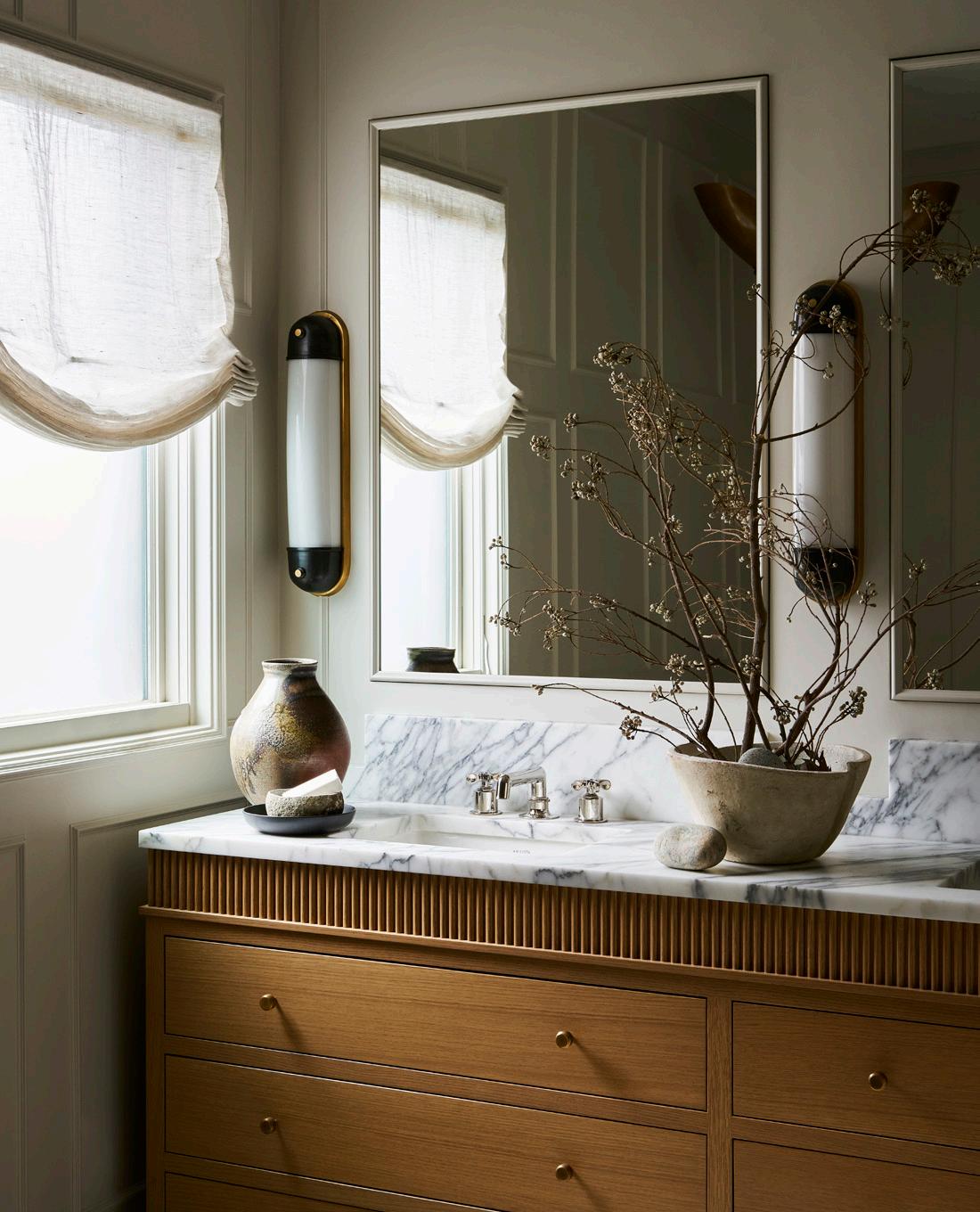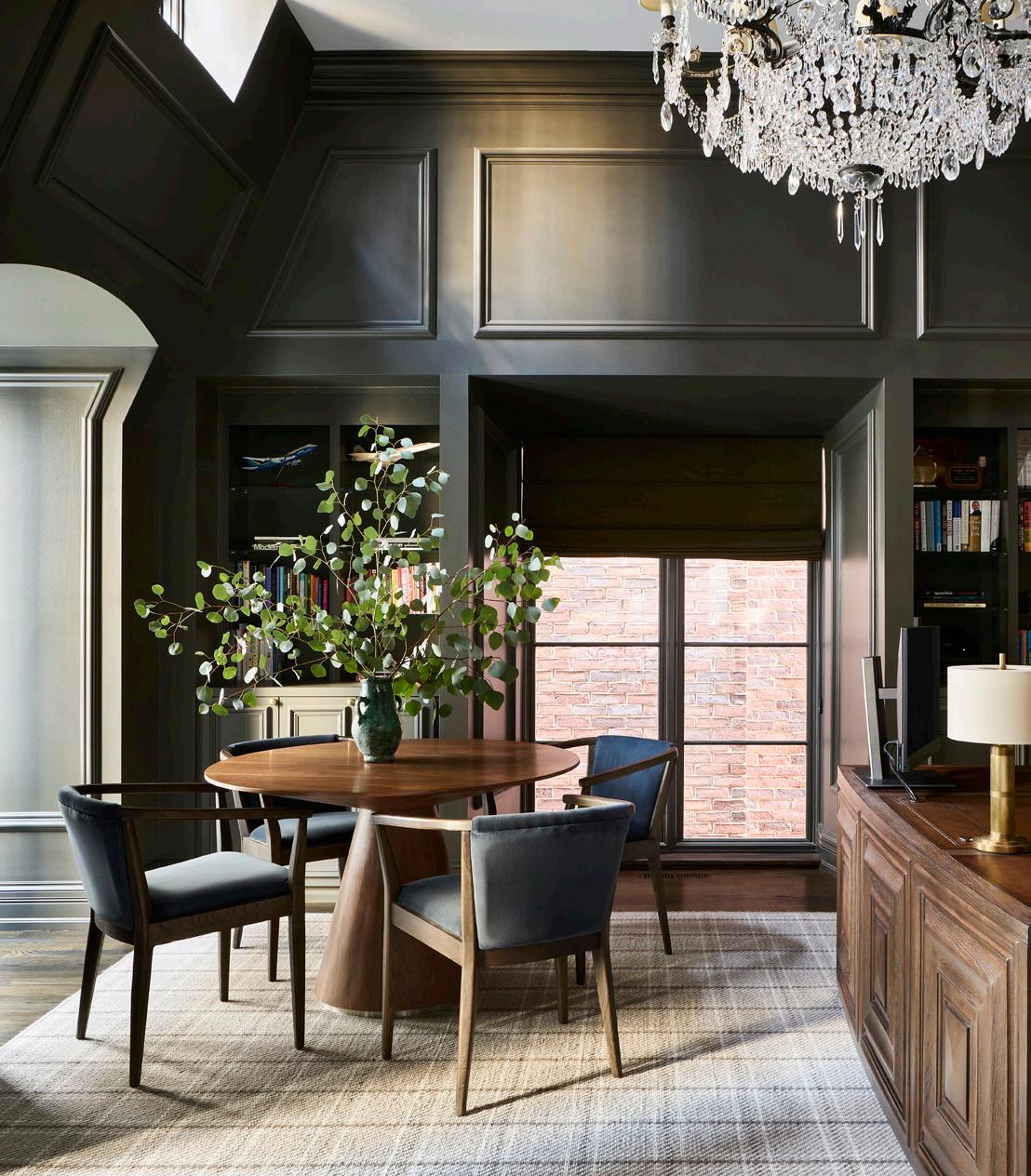
6 minute read
picture picture PERFECT
A GUIDE TO HIRING AN INTERIOR PHOTOGRAPHER
STYLING MATTERS
Design by ALISSA JOHNSON INTERIORS. This image offers a perfect example of what a good stylist (KIMBERLY SWEDELIUS) can do to bring a designer's work to life in an image. Everything from the way the throw pillows peek into the foreground to the way the floral arrangement draws the viewer into the space are touches the stylist offered to make the design pop.
PHOTOGRAPHER: Ryan McDonald
SITE: rmcdon.com
LOCATION: Chicago
HIRING A PROFESSIONAL TO PHOTOGRAPH YOUR HOME OR INTERIOR DESIGN PROJECT GIVES YOU THE MOST POTENTIAL TO SHOWCASE YOUR HOME OR WORK IN THE BEST POSSIBLE MANNER. UNDERSTANDING WHAT IS INVOLVED IS CRITICAL TO GETTING THE RIGHT PERSON. HERE, INTERIOR PHOTOGRAPHER RYAN McDONALD SHARES HIS TIPS FOR CHOOSING THE RIGHT PERSON AND GETTING THE IMAGES YOU NEED, WHETHER THAT'S FOR SELLING YOUR HOME OR PROMOTING YOUR INTERIOR DESIGN BUSINESS.

SLM: Tell us a bit about yourself.
RM: I embraced photography from an early age, as my father worked for storied commercial architectural photography firm Hedrich Blessing for many years. I grew up learning the trade from him, began assisting on set as a teenager, and ultimately attended the School of the Art Institute of Chicago for photography. I've been behind the camera ever since, primarily documenting residential interiors.
SLM: What should designers consider when choosing a photographer?
RM: There are obvious basics like rates and schedule availability to consider, but there are some things that I think can get overlooked initially that end up being important when designers are forming a working relationship with a photographer. It's important to understand whether they bring lighting, shoot with natural light, or a combination of both - each will net different results in the photos. Getting an understanding of approximately how many images they get in a day also is important; each photographer approaches this differently. Most established photographers have a contract or FAQ document that dives into the details; read the fine print and ask questions so you can start things out on the right foot and avoid surprises, as there are truly so many variables.
SLM: What makes a house "ready to photograph"?
RM: Most designers want to wait until all product is installed and the details are fine-tuned before they photograph, but something commonly overlooked is the cleanliness of the space. Lots of time can be saved if surfaces are clean and everything is tidy ahead of shoot day.
SLM: How can designers make the most of the photo shoot day?
RM: This may seem obvious, but staying focused is so key to a successful shoot. Designers are very busy people, but when they take conference calls and respond to emails throughout the day, it dramatically slows things down. Keeping the energy with the photographer while staying focused on the shot list will drive the photo count up, every single time. Speaking of shot list, being clear at the start of the day on what exactly you want photographed is important as well. I typically walk through the house with my client and discuss what absolutely must be documented and what is nice to have if we have time. That list drives the pace of the day.
SLM: Who are other important contributors on set?
RM: Many photographers have an assistant with them during photo shoot days. Assistants keep things moving by setting up lights, straightening blankets, holding reflection discs, and other tasks that, when taken together, make a major positive impact on the day. My favorite shoots also include a stylist. Contrary to what some may expect, photo stylists aren't there to compete with the designer's vision - rather, they bring the design to life by helping it jump off the page. They understand how to create depth in the image by adjusting a chair, bring a sense of vibrancy with florals and plants, and incorporate a lived-in feel with a perfectly placed set of slippers.
Let It Shine
Design by DAN RAK DESIGN. An example of allowing natural light coming from multiple sources within a room to bounce around and work its magic.
STIRRING
Emotions
Design by ANNA KNIGHT INTERIORS. This photo demonstrates the way diffused natural light can bring a certain kind of mood to an image. The soft light streaming in evokes a sense of authenticity and makes it feel almost like a memory.


Their work makes the designer's work sing on the pages of a magazine and on social media.
SLM: How do image usage rights work?
RM: Every photographer approaches this a bit differently, but in general, it can be helpful to re-frame it in the mindset of a designer. If a designer created a design for a paying client, and that client then handed those drawings or ideas directly over to someone else to use for free, that wouldn't feel right. That's because those ideas, the right to use those designs - they're what the designer is selling. Similarly, the right to use my images is what I am selling. So, passing them off to another party to use breaks most photographers' usage policies. If a request like this comes in, it's best to check with the photographer to understand how they would like to manage it.
MORE TO CONSIDER WHEN HIRING AN INTERIOR PHOTOGRAPHER:
EXPERIENCE AND PORTFOLIO - Look for a photographer with experience in shooting interior designs. Check out their portfolio to see if their style and quality of work aligns with what you are looking for.
EQUIPMENT - Ensure that the photographer has the right equipment to capture your interior design. This includes high-quality camera gear, lighting equipment, and editing software.
LIGHTING - Lighting plays a crucial role in interior design photography. Make sure the photographer knows how to work with natural and artificial light and can use it to highlight the design features of your space.
ATTENTION TO DETAIL - A good interior design photographer should have an eye for detail and be able to capture the essence of your design with precision.
COMMUNICATION AND COLLABORATION - Ensure that the photographer is open to collaboration and can communicate effectively with you to understand your vision for the shoot.
POST-PRODUCTION - Find out if the photographer offers post-production services such as retouching and editing. This can help enhance the overall look of your interior design and create a more polished final product.
COST AND TIMING - Discuss the cost of the shoot upfront and confirm the timeline for delivery of the final images. Make sure the photographer is clear on your budget and can deliver quality work within your time frame.
Natural Habitat
continued from page 22 space. The bedrooms, each with a private bathroom, and a second office are on the 2nd level.
SLM: How did you incorporate elements of wellness into the space?
LC: We used large floor-to-ceiling windows placed in accordance with compass sun orientation. The bathrooms are maximized for wellness as well, with large soaking tubs and steam showers. All of the materials used in this home, from the wood we used in the build to the wall finishes to the furnishings are sustainable, healthy, and noble materials that protect the client’s health and do far less damage to the environment than the alternatives. We also built in many smart-tech elements: smart kitchen appliances, HVAC EPAapproved systems, water-efficient faucets and toilets, and lighting and window treatments on timed routines.
SLM: How did you address sustainability?
LC: As the founding principle of my business, sustainability was prioritized from the very beginning. We explained to our team of contractors the importance of implementing these materials from the ground up. We used third-party certified materials (like FSCcertified wood), and innovative bio-materials created specifically for sustainability (such as the MOGU tile and Durat ecological solid surface material in bathrooms). We sourced brands that offer transparency about their processes such as Cisco Home, Coco Mat, Roche Bobois, Rhyme Studio custom wool rugs, and Farrow & Ball paint, and we focused on efficiency and reuse including antique furniture as much as possible.
SLM: What are you most proud of regarding this project?
LC: This is hard to narrow down! Overall, the mindfulness with which the home was designed makes me most proud. No detail was left spared to create a space that represents the best of beauty, sustainability, functionality, and wellness-enhancing elements. My greatest reward is knowing that I was part of the feeling the client enjoys when walking into their home after a long day, the memories they will create with family and friends, the compliments they receive from visitors, and the comfort in knowing that everything in their home supports their happiness, health, and wellbeing.
SLM: Are there any particular points of interest we should note?
LC: Because art has always been such an influence in this family's life, we sought out unique and interesting mixed-media fine art pieces with the help of Velvenoir Art Consultancy. Extraordinary pieces from emerging artists like Bobbie Burgers in the music room and Nike Schroeder in the large living room bring amazing color, interest, and life into the home.
The furniture is an eclectic mix of contemporary sustainable brands and vintage and heirloom pieces sourced globally from this client’s extensive travels. They love looking around and seeing echoes of the places that left imprints on their heart in the decor and design. Mementos are important elements of a home, they ground one’s footprint in the space. Sustainablymade sculptural vessels, from a capsule collection I am launching this spring, are also on display.
Balancing the modern and ancient is a juxtaposition that brings such visual intrigue into a space and offers opportunities for cherished global objects and antiques to retain relevance, even in contemporary environments like this.










